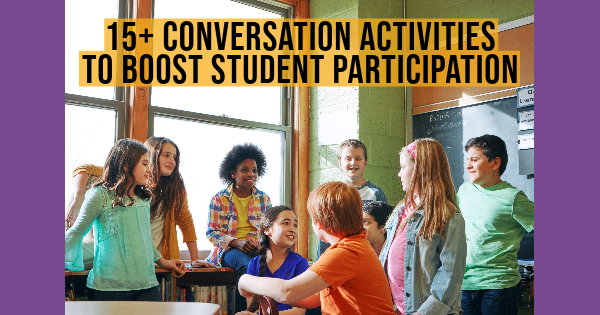15+ Exciting Conversation Activities that will Boost Student Participation
 Julia Barreiro —
Julia Barreiro —
One of the most valuable skills a student can acquire is communicating effectively. Fostering classroom conversations is an essential step in nurturing this skill in education. In this blog post, I present over fifteen exciting conversation lesson ideas to boost students’ participation and promote this skill. Whether you’re an elementary school teacher looking to grow your students’ confidence or a high school educator aiming to stimulate critical thinking, various conversation activities can help you achieve these goals. I’ve divided them into different levels, but you can adapt them to your teaching level.
- Conversation activities for elementary school
- Conversation activities for middle school
- Conversation activities for high school
- Conversation activities for language courses
💡 Digital Tips Explained! As you will see, I’m sharing some BookWidgets tips for our widgeteers or some ready-to-use digital alternatives to the conversation lesson ideas below. These are interactive lesson ideas (=widgets) you can duplicate for free (open the activity and make a copy in your account) and use in your classroom. After duplicating, you can even make changes to the activity. If you’re new to BookWidgets, let me shortly explain: BookWidgets is a content creation and evaluation tool for teachers.

Conversation activities for elementary school
In elementary school, students are at a stage where they are developing their basic communication skills. Here are a couple of activities designed to encourage them to speak in front of their peers and express themselves:
1. Show and Tell

This classic activity invites students to bring an object from home and share it with the class. It’s an opportunity for young learners to describe the thing, its significance, and why they chose to share it. “Show and Tell” helps young learners practice speaking in front of their peers and develop the confidence to express themselves.
💡 Digital tip: Instead of bringing an object from home, students can draw the object they want to show. They can do this on paper or digitally using this whiteboard widget in BookWidgets you created for them. You can also ask them to upload a picture of the object and write a few keywords that will help them with telling about their object, the next day in class. This activity is also a fun classroom icebreaker for the first day of school!
2. Storytelling Circle

Sitting in a circle, students embark on a collaborative storytelling adventure. Each student adds a sentence or two to continue the narrative. This dynamics fosters creativity, listening skills, and the art of taking turns as students collaboratively weave a story together. This activity can be challenging, especially for shy students, who might need some input.
💡 Digital tip: Consider having some visuals ready to be included in their story. You can bring realia or use a digital random picture album. The teacher click the “random” icon in the upper right corner, and a new picture appears! The fun is guaranteed when unexpected elements need to be added to the story.
3. Picture Cards Discussions

Utilizing picture cards depicting various scenes, objects, or emotions, students choose a card and describe what they see or feel. This activity helps improve vocabulary and encourages young learners to express themselves.
💡 Digital tip: Using a Padlet board with several pictures for students to pick from saves time and paper in the preparation of this activity.
4. 20-question game

One student thinks of a person, place, or animal. The rest of the class asks yes/no questions to try to determine what the person is thinking of.
The idea is to help students build their critical thinking skills by asking questions in a logical order that will help them guess the item.
💡 Digital tip: Here’s a fun alternative to the activity, called: Mystery Video-Conference. A vetted speaker or other class is invited to meet (digitally) with your classroom. Students ask questions to try to guess the location of the speaker/class or the secret animal/number the class is thinking of. After both classes have taken a turn, follow up with a classroom discussion.

Conversation activities for middle school
As students progress into middle school, their communication skills should also mature. They should gain more confidence and practice considering different points of view before giving their opinion. Here are some activities suitable for this level:
5. Agree/Disagree/Discuss

Draw a line on the board to divide the classroom into two. Write “agree” on the left side of the board and “disagree” on the right one. Have all students lined up in the center. Pose a prompt with which students should move left or right in order to show if they agree or disagree with the statement. Have students pair up after each statement in order to give their arguments in favor or against it.
💡 Digital tip: You can read the prompts out of a list or make it more interactive by having students take turns spinning the wheel of this randomness widget. Depending on the subject you teach you can have questions related to the topic to make it more interesting. Go check out this blog post with more ideas with BookWidgets’ randomness widget. Here’s another digital tip! Ask ChatGPT to “create 20 prompts (about topic xxx) students have to agree or disagree with to spark a classroom discussion”.
6. Would you rather

This popular party game can also be played by your middle school students to bring some fun and give input to interesting group conversations. Gather students in a circle or a group and take turns posing thought-provoking dilemmas, beginning each with “Would you rather…” Participants must then choose one of the two options presented, and it often leads to classroom discussions and debates.
Encourage students to explain their choices, creating an engaging and fun environment for sharing opinions and getting to know each other better. The game fosters critical thinking, creativity, and communication skills while also providing a light-hearted and enjoyable way for students to connect and bond. Here are some ready-to-use examples:
Would you rather have the ability to time travel to the past or to the future?
Would you rather be an expert musician but unable to read or write or a brilliant writer but unable to play any musical instrument?
Would you rather always tell the truth but hurt someone’s feelings or tell a white lie to spare their feelings?
Would you rather have the power of invisibility or the ability to fly?
Would you rather be a famous celebrity with no privacy or an ordinary person with complete anonymity?
Would you rather live in a world with no television or no mobile phones?
Would you rather have unlimited access to your favorite food but never be able to travel or travel the world but only eat broccoli?
Would you rather be the best student in a mediocre school or an average student in a prestigious school?
Would you rather have the ability to speak and understand all languages or be a master of every musical instrument?
Would you rather have the power to change the past or the ability to predict the future?
7. Back-to-back game

This converation starter activity for high school students encourages not only speaking but also creativity and active listening. Have students sit in pairs and ask them to sit with their backs to each other so that they cannot see what the other person is doing. One student describes something like a drawing or picture that is not easily replicated. The other student attempts to recreate the drawing based on this description. It encourages the first students to give clear instructions and the other must listen carefully and replicate the instructions. It’s a good lesson to learn what can go wrong in communication when your students failed to replicate the picture.
💡 Digital tip: Give the student that has to draw and replicate the picture a smartphone or tablet to draw on. Provide them with a quiz widget with a whiteboard question so they can draw by listening to the instructions. When the drawing is done, ask your students in a follow up questions to analyse the drawing and write down where they went wrong or what happend when they couldn’t replicate the drawing. The same goes for when your students finish the assignment pretty good. They can reflect on what went well in their communication.

Conversation activities for high school
On this level, it’s essential to encourage critical thinking and foster argumentative skills. For students in high school, I like bringing thought-provoking questions and providing activities that will allow them to speak their minds.
8. Critical thinking circles

Assign different articles around the same topic to small groups of students who read and discuss the assigned material. They can then share their insights, interpretations, and reactions with the entire class. This kind of activity promotes in-depth analysis and critical thinking. Some ideas for critical thinking circles include:
Media Literacy and Fake News: Explore how to discern between credible and unreliable sources of information, discussing the impact of fake news on society and how to fact-check.
Ethical Dilemmas in Technology: Discuss ethical concerns related to technology, such as privacy, surveillance, and the responsible use of social media.
Climate Change and Sustainability: Analyze the implications of climate change, debate potential solutions, and consider individual and collective responsibilities for a sustainable future.
Social Justice and Equality: Examine issues of social justice, such as racism, gender equality, and economic disparities, and discuss strategies for promoting a more just society.
Artificial Intelligence and Automation: Consider the impact of AI and automation on the job market, ethics, and society as a whole. Discuss potential challenges and opportunities.
💡 Digital tip: Provide them with a digital mind map to take notes during their small group discussion. They can add boxes with keywords, insights, interpretations on the topic. It will help them sturcture their thoughts when they are sharing their findings with the whole class.
9. Philosophical Chairs

Set up a debate-style discussion where students take positions on a controversial topic, and they can switch sides based on the arguments presented. This activity encourages students to explore different perspectives and engage in meaningful dialogues. You can give each group a list of controversial topics to choose from, and they can defend their actual positions.
💡 Digital tip: To make this activity more challenging you can use a randomness game. When students click on the “spin” button, they will be assigned a topic and either the word “agree” or “disagree.” They will have to defend their assigned point of view even if their actual opinion is the opposite of that. This is good for practicing argumentation and switching viewpoints.
10. Video-Based Discussions

Bring videos related to topics of interest or social issues. Encourage your high school students to express their opinions, debate, and analyze the events from multiple angles.
Using video in class is a nice change of pace and promotes student engagement. Here’s a video quiz with a provoking video for discussion and some comments that are good input for discussion.
You can change the dynamics to make this activity even more engaging. Divide students into groups and have each group, at home, choose a video from YouTube that they find touching, provoking, or interesting. They should prepare questions for discussions based on the video but not answer them. Then, in class, each group assigns their chosen video with the questions to another group.
Each group watches a different video and discusses the questions. After this initial activity, a discussion in plenum can take place so all the topics can be discussed by everyone.
11. Structured debate

Organize debates on relevant topics, allowing students to research, form arguments, and present their views in a structured discussion format. Debates encourage critical thinking, persuasive communication, and active listening.
This activity is the perfect opportunity to introduce or review useful phrases used for debates. Prior to the debate itself, give students an activity to have them categorize the different types of useful phrases, which they will then need in their discussion. If you have time to spare, you can create flashcards with each useful phrase, draw a table on the board, and hand in a card to each student, which they can then categorize in class.
💡 Digital tip: If you prefer to use a ready-to-use digital activity, click here. You can duplicate the activity and edit it if you want to include more phrases or delete some.
12. Make a Commercial

Encourage students to practice the art of persuasion to convince their classmates or others to purchase a product. Students (individually or in groups) select an item and create a one-minute commercial about it. Use the recording platform of your choice, such as Flip, Adobe Express, mmhmm, or your phone/computer. Students should make sure to include the following in their recording:
- What makes their product special? = Unique selling proposition
- How can it enhance the consumers’ life?
- Why does the consumer need this product?
Classmates can vote for the best commercial.
No access to recording? No worries, this can also be accomplished live in class. This is a great activity to focus on listening, speaking, and writing skills.

Conversation activities for language courses
Whether you teach English, Spanish, French, or German, or are a teacher of any other foreign language, having effective and fun classroom conversations is essential for students of all ages. Of course, you can use any of the ideas above with your language groups as well, but the ideas below are taught specifically for language learners.
13. Role-Playing Scenarios

Create real-life scenarios or dialogues that students might encounter in the target language. Students role-play these situations, fostering practical language use and communication skills. Here are some common scenarios for adults:
Airport Scenario: Practice travel-related vocabulary and communication by role-playing airport scenarios, including check-in, security checks, and asking for directions.
Hotel Check-In: Simulate the check-in process at a hotel, with students playing the roles of guests and hotel staff, focusing on reservations, room preferences, and services.
Doctor’s Office: Practice medical vocabulary and communication by having students play the roles of patients and medical professionals, discussing symptoms, prescriptions, and health concerns.
Job Interview: Simulate job interviews to help students practice professional language, discussing qualifications, strengths, and job-related questions. This is also a good topic for high school students.
Real Estate Agent: Explore the language of property transactions by role-playing scenarios where students act as real estate agents and clients, discussing housing options and preferences.
Grocery Shopping: Role-play a trip to the grocery store where students act as shoppers and store clerks, discussing items and prices, and making purchases.
Restaurant Review: After dining out, have students write and present restaurant reviews in the target language, discussing the meal, service, and overall experience.
Travel Agency: Role-play travel agency interactions, with students as travel agents helping clients plan vacations and discussing destinations, accommodations, and itineraries.
💡 Digital tip: Provide this assignments as homework so students keep practicing their language skills. Ask them to record a dialoge using the audio recording question in BookWidgets. Here’s a video quiz lesson example to practice dialogues and newly learned vocabulary.
14. News Analysis

Bring in news articles or reports in the target language. Students read and discuss these articles, summarizing the key points, sharing their thoughts, and debating various aspects of the news.
This activity enhances language proficiency and cultural awareness. When using authentic material, it’s important to make sure that the language of the source is suitable for the level you’re teaching.
💡 Digital tip: What I do when preparing this kind of material for my groups is using ChatGPT to adapt the text. So, for instance, I copy an article I find interesting into ChatGPT and ask the AI tool to: “simplify the text for a group of 4th grade students”. I then create a split worksheet with the text on one side and questions on the other side. These serve as input for analysis and will get the students talking. Click here to see an example.
15. Language Exchange Partners
 Pair students with native speakers or peers learning the same language. You can collaborate with other teachers you know and organize this as a long-term project, which can be carried out online. Encourage them to engage in regular conversations or language exchange sessions, where they discuss topics of interest, share experiences, and improve their language fluency through dialogue.
Pair students with native speakers or peers learning the same language. You can collaborate with other teachers you know and organize this as a long-term project, which can be carried out online. Encourage them to engage in regular conversations or language exchange sessions, where they discuss topics of interest, share experiences, and improve their language fluency through dialogue.
16. Celebrity Interviews

This activity is a fun way to have students practice question words and use simple present, simple past, and present perfect. Students are divided into pairs, in which one is the interviewer and the other one a celebrity. You can have students choose who they want to pretend to be freely, or you can give them a list for them to choose from, in case you want to avoid inconvenient choices.
💡 Digital tip: Alternatively, you can have two celebrities interview each other. For this, it’s fun to have students leave it to faith which celebrity they will pretend to be.
17. Untranslatable?

If you have students in your classroom who speak different native languages, chances are they’ve encountered words that don’t have direct translations in English. You can leverage their knowledge of their own languages to foster discussions within the classroom.
Form small groups of students, ideally including members from two or more native language backgrounds. Even if the group shares a common native language, there are often distinct dialects, regional expressions, and unique experiences that can lead to discussions about these “untranslatable” words and their potential English interpretations. Each student compiles a list of five to ten words that they find challenging to translate directly into English (or any other target language). In turn, students explain the meaning of the words on their list using the target language. Then, following the word presentation, the other students can ask questions and seek clarification regarding the word’s meaning and usage.
💡 Digital tip: Provide students with a digital mind map to indicate their 5 words and their potential English interpretations. Students can submit their mind map to the teacher. This way, the teacher can gather all the native words and meanings and present them in a list to all the students. You can even make a wall poster out of it using Canva as a design tool!
Wrap up
In conclusion, effective communication is a skill that holds immense value in the realm of education. The ability to articulate thoughts and engage in meaningful conversations is not only essential for academic success but also for personal and professional growth. In this blog post, we have explored a wide range of conversation activities, discussion starters, and debate topics tailored to different educational levels, from elementary school to high school and language courses. These activities are designed to nurture students’ communication skills, boost their confidence, and stimulate critical thinking.
You can find all ready-to-use activities used in the examples here and duplicate them to your own account in order to edit them and share them with your students.
I’d like to know which of these activities is your favorite and what other ideas you have, so do share with us. Let us know on Twitter - X - and join our Facebook community to share your first history BookWidgets activity with other teachers.
Feel free to connect with me on LinkedIn. I’m looking forward to hearing from you.


